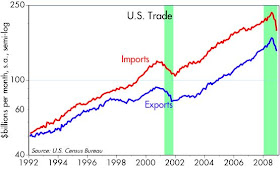 Data through November point to global trade hitting a virtual "air pocket." July was the peak month for trade, and it was just after July that things started really going south. Exports fell $25.5 billion (at a seasonally adjusted monthly rate) through November, probably the most rapid decline since the Smoot Hawley tariffs that helped trigger the Great Depression. But imports fell $46 billion, almost twice as much. The GDP data will record this as a significant boost to growth, interestingly, since exports did much better than imports.
Data through November point to global trade hitting a virtual "air pocket." July was the peak month for trade, and it was just after July that things started really going south. Exports fell $25.5 billion (at a seasonally adjusted monthly rate) through November, probably the most rapid decline since the Smoot Hawley tariffs that helped trigger the Great Depression. But imports fell $46 billion, almost twice as much. The GDP data will record this as a significant boost to growth, interestingly, since exports did much better than imports.And so it is that trade acts as a shock absorber for consumers' sudden reluctance to spend, and the rest of the world shares our pain. Adding to the problem of consumers' reluctance to spend as the financial crisis deepened, trade was also impacted by banks' unwillingness or inability to extend letters of credit, an essential component of cross-border trade. Shipping activity declined sharply, as reflected in the collapse of the Baltic Dry Index (shipping costs) from 11,000 in May to a mere 663 in early December.
Fortunately, it appears that trade is no longer in free-fall. The Baltic Dry Index has risen 34% since its low in early December. Similarly, but in magnified fashion, Dryships (which owns and operates drybulk carriers) shares have risen 340% since their low in late November (HT to Mike Churchill). With Libor rates down significantly (reflecting banks' renewed willingness to lend to each other), and shipping rates and commodity prices up, we can deduce that banks are once again making letters of credit and trade is ramping back up. This all adds up to good news for our economy as well as for the global economy.

You are invaluable. Please keep posting.
ReplyDeleteWilliam S. Smith
Chairman of the Board
United Labor Bank
Scott -
ReplyDeleteThis article lends support to one of your topics of discussion from late last week, namely the potential for a recovery as dramatic as the decline.
http://money.cnn.com/2009/01/12/news/economy/strong_recovery/index.htm?postversion=2009011216
A V-shaped recovery has not been at the forefront of very many minds. We certainly weren't seeing any mainstream proponents. Perhaps Chris Isidore should have sourced you . . . or his sources should have sourced you!
Thanks, and the article does a good job describing why a V-shaped recovery is likely.
ReplyDelete